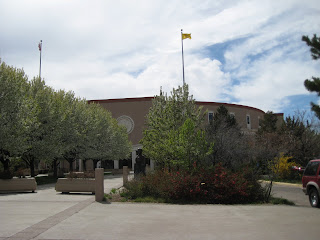Last night in Ventana Canyon was great. One of the engineers on the Mars Mission gave a great presentation on the project. He also answered many stupid questions, with great patience and grace. Such as, "which Universe is Mars in?" I wish I were kidding. He earned his paycheck, for sure.
There were also several telescopes set up. I got to see Mars (of course), and Saturn. When one of the grad students said the sky constantly changes, and Saturn looks different from week to week, I got to Nerd name-drop with, "Yeah, I was at
the Lowell a few weeks ago and it looked very different". I think I may have pushed my glasses up while I was saying it.
Today was the big event. I headed to the University to find huge crowds waiting to get into the presentations. Before I got in line, I took a look through a telescope fitted with a solar lens and pointed at the sun. The sun...looks like a plain white ball, no flames, no shimmering. I guess it was a boring day to view it, no sunspots or solar bursts. But, it was nice to look at the sun without worrying about searing my retinas.
The Space Imagery Center was open for visitors, and we had an all access pass. "Sure, pull open those drawers, the photos from Apollo 13 are in there." A half million images, literally at our fingertips. Another time I can't believe they let the public access this stuff. It was pretty neat. A lot is viewable on line,
here.
I then took a seat in the auditorium to watch a bit of the NASA Channel. That's right, I said NASA Channel. Apparently you can watch NASA if you have the right cable provider. AWE-some.
The auditorium was standing room only when
Bill Boynton started his presentation. He's one of the big guys on the project, I was amazed he agreed to be with the public instead of with his teams for the big event. He didn't have a presentation prepared ("I've been a little busy"), so he spent 30 minutes answering questions. Then, we all watched together as the clock hit 4:38, and the lander theoretically landed on Mars.
Because Mars is 422,000,000 miles away, it takes some 15 minutes for data to travel to Earth. While the landing happened at 4:38, it wouldn't be until 4:53 that they would receive confirmation it was a successful landing. I only learned about the Mars Mission on Friday night; I was on the edge of my seat with knots in my stomach for those 15 minutes. I can't imagine what those who've been involved from the beginning were feeling. With each passing milestone (heat shield separation, parachute deployment), the crowd cheered. And then there'd be silence until the next piece of data came in.
Half a billion dollars, 7 years of work, a 250 ton rocket to launch it into space, and a nine-month 422 million mile journey at 74,000 miles per hour. At 4:53, confirmation of landing. The crowd erupted. There may have been some spontaneous precipitation in my ocular area. It was an amazing moment.
It's really hard to believe that something that was built in California is now sitting near the north pole of Mars. 50% of the missions to Mars have failed, so it is a real accomplishment. And, not only did it land intact, it was pretty much a perfect landing. They programmed this machine to do some stuff, launched it into space, then waited for 9 months, and it worked perfectly.
Perfectly. Astounding.
The first
images from the lander are up on the website. The first experiments start next week. I have no doubt that throughout Tucson, there are many drunk engineers celebrating their achievement.























































